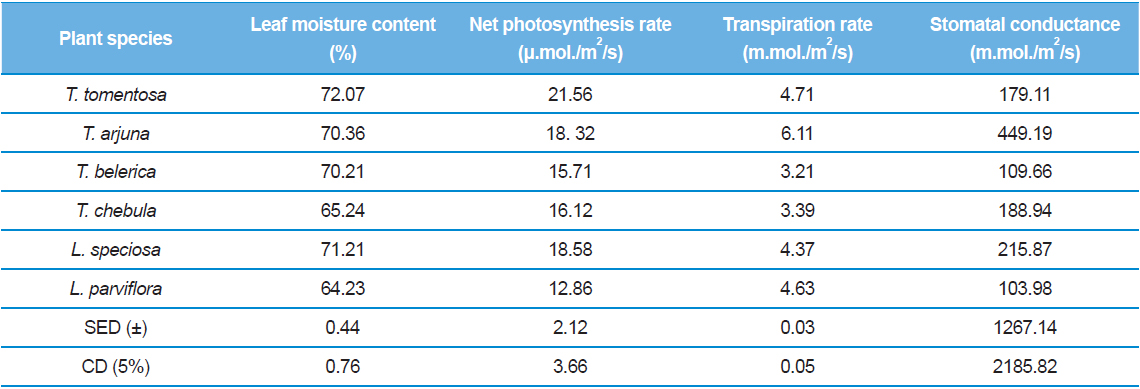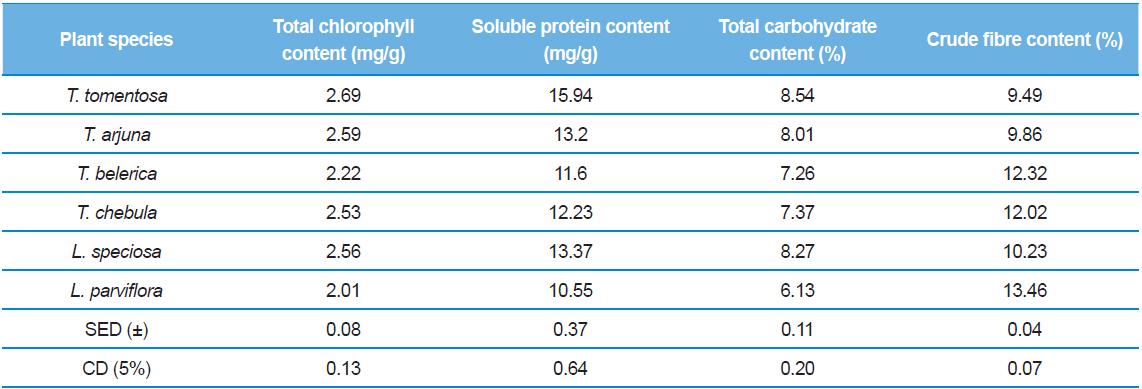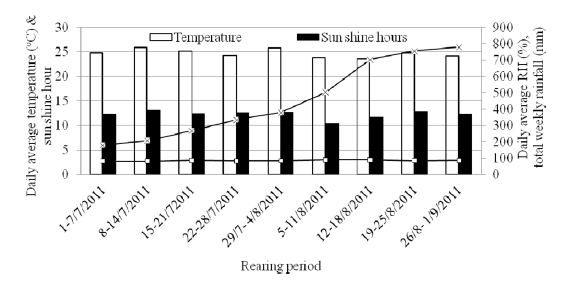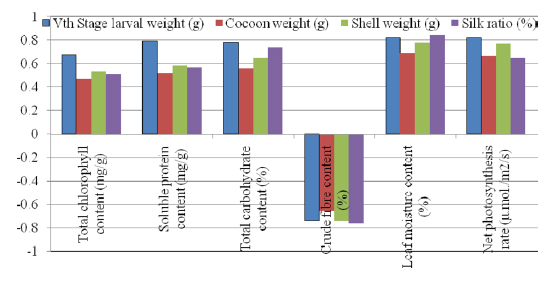



An experimental rearing of tropical tasar silkworm, Antheraea mylitta Drury was conducted to study silkworm-food plant-interaction and thereby to search for an alternate silkworm food plant. The silkworm-food-plant-interaction was studied with six different food plant species viz. Terminalia tomentosa, Terminalia arjuna, Terminalia belerica, Terminalia chebula of Combretaceae family and Lagerstroemia speciosa, Lagerstroemia parviflora of Lythraceae family. The rearing performance of silkworm on Lagerstroemia speciosa in terms of cocoons per DFL and silk ratio was found comparable with Terminalia tomentosa and Termonalia arjuna, the primary tasar silkworm food plant species. These three plant species also possessed better results in terms of physiological (leaf moisture content and net photosynthesis rate) and biochemical (Chlorophyll, protein, carbohydrate and crude fibre contents) characteristics to support silkworm rearing than Terminalia belerica, Terminalia chebula and Lagerstroemia parviflora. The correlation study between silkworm rearing performance and food plant’s constituents indicates commercial perspective of Lagerstroemia speciosa as an alternate food plant for tasar silkworm rearing.
Sericigenous tasar silkworm is polyphagous, feeding primarily on
The constituents food plant affect silk production of the insect profoundly, affecting on survival behaviour, rate of quantity of food-intake, digestion and assimilation, which directly influence the growth and development of the silkworm (Krishnaswami
In the present study, rearing of Daba ecorace of tasar silkworm (
>
Evaluation of silkworm rearing performance
The silkworm rearing performance was evaluated by recording larval duration (from the date of brushing to cocoon formation), Vth stage larval weight, cocoon weight, shell weight, effective rate of rearing [ERR% = 100 × (Total number of cocoons harvested/Total number of larvae brushed)] and silk ratio [SR% = 100 × (Shell weight/Cocoon weight)].
>
Evaluation of physiological characteristics of food plant
Leaf moisture content (MC) was determined on fresh weight basis using following relation. To determine oven-dry weight, leaves were placed in an oven at 70℃ for more than 24 h till the constant weight was obtained.
MC (%) = [100 × (Fresh weight – Oven dried weight)/Fresh weight)]
Other physiological parameters viz. net photosynthesis rate, transpiration rate and stomatal conductance of leaf were evaluated using universally accepted CI-340 Photosynthesis System.
>
Evaluation of biochemical characteristics of food plant
Chlorophyll a, chlorophyll b and total chlorophyll content
Chlorophyll extraction and estimation (mg/g fresh weight) of leaf tissue was carried out according to spectrophotometric method (Anderson and Boardman, 1964).
Total soluble protein content
Total soluble protein (mg/g dry-weight) in the leaf was determined following the spectrophotometric method (Lowry
Total carbohydrate content
Total carbohydrate content (%) of leaf was determined following the Anthrone method (Hedge and Hofreiter, 1962).
Crude fibre content
The crude fibre content in leaf was determined according to oxidative hydrolytic degradation process (Maynard, 1970).
Statistical analysis
The correlation study between silkworm rearing performance and food plant’s constituents was carried with standard statistical procedures. All other observed data with five (5) replications were analyzed statistically using the techniques of analysis of variance. The significance of treatment (food plant species) differences was judged by ‘F’ test (Cochran and Cox, 1963).
The standard error of the differences (SED±) was calculated by using following expression.
SED± = √(Error mean square × 2/pooled number of replications)
The critical differences[CD] were calculated to test the significant differences of the treatments. Critical differences were calculated by using following formula.
C. D. (5%) = (SED±) × ‘t’
where, t = 5% tabulated value of ‘t’ at error degree of freedom.
The essential information regarding present experimental rearing is as follows.
1. No. of Disease Free Layings[DFLs]: 3
2. Fecundity: 200 (1 DFL is having 200 healthy eggs)
3. Source of DFLs: BSMTC, Bhagalpur, India
4. Date of coupling: 03.07.2011
5. Date of hatching/brushing: 11.07.2011
The rearing data of silkworm are presented in Table 1. It reveals that the lowest larval period of silkworm was recorded in
[Table 1.] Rearing data of tasar silkworm

Rearing data of tasar silkworm
The silkworms reared on different food plant species showed significant difference in rearing performance (Table 2). The correlation between silkworm rearing performance and food plant characteristics is depicted in Fig. 2. It shows that there is strong positive correlation between silkworm rearing performance (Vth stage larval weight, cocoon weight, shell weight & silk ratio) and physiological (leaf moisture content and net photosynthesis rate) and biochemical (total chlorophyll, soluble protein and total carbohydrate contents) characteristics of food plants. However, rearing performance of the silkworm is negatively correlated to crude fibre content of leaf of the food plant species.
[Table 2.] Tasar silkworm rearing performance on different food plant species

Tasar silkworm rearing performance on different food plant species
Comparatively, higher larval weights resulted higher cocoon weights in
In the present experiment, all plant species showed significant differences in respect to physiological properties (Table 3). The leaf moisture content, which is having positive correlation with silkworm rearing performance (Krishnaswami, 1978; Thangamani and Vivekanandan, 1984) was recorded the highest in
[Table 3.] Physiological properties of different food plant species

Physiological properties of different food plant species
[Table 4.] Biochemical properties of different food plant species

Biochemical properties of different food plant species
All the food plant species in the present experiment showed significant differences in respect to biochemical properties (Table 4). The highest value of total chlorophyll content of leaf was recorded in
In the present study, it was found that the leaf of food plant with more moisture, protein, carbohydrates and less crude fibre is the best from tasar silkworm nutritional point of view, which was reflected in terms of better rearing performance of the silkworm on
From the present study, it can be concluded that the rearing of tasar silkworm,






